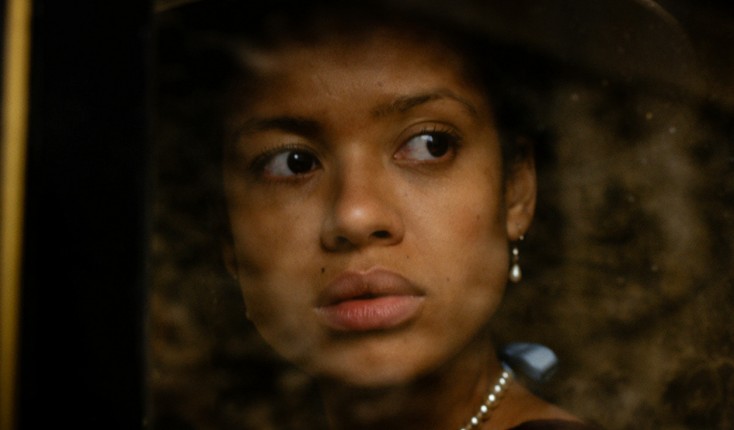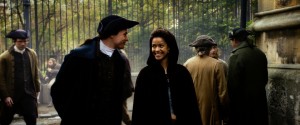By ANGELA DAWSON
Front Row Features
HOLLYWOOD—A visit to Scotland’s Scone Palace in the mid-1990s proved fateful for Misan Sagay, a medical student at the time attending nearby prestigious St. Andrews University. While walking through the rooms, she spied a beautiful painting. The 200-year-old unsigned artwork intrigued the Nigerian-born, London-bred daughter of a diplomat, because it depicted two elegantly dressed women who appeared of equal social standing, one black and one white. The guidebook identified the white woman as Lady Elizabeth Mary Murray, daughter of the Earl of Mansfield. There was no identification of the other woman.
Years later, when Sagay returned the palace, the updated brochure identified the black woman as a servant. That description, though, seemed incongruous with the depiction of the two women, who appeared to be enjoying a moment of leisure together. That’s when Sagay, who by then was a doctor, decided to research on the painting. Thanks to a family connection, she discovered that the black woman in the painting was Dido Elizabeth Belle, daughter of a white British naval captain and an African woman who likely was a slave.
The bi-racial Dido and Lady Elizabeth were raised together by Lord Mansfield, the high-ranking judge who helped bring about the abolishment of slavery in Britain. Her discovery led Sagay to write the screenplay “Belle,” which tells the story of a mixed race woman who leads an unusual life of aristocratic privilege in 18th century England, but because of the color of her skin, cannot fully realize the complete status of her birthright. She falls in love with an impassioned young anti-slavery advocate, and together they try to sway the opinion of the powerful jurist on an important case involving the slave trade. Amma Asante (“A Way of Life”) directs the film from Sagay’s script, and stars Gugu Mbatha-Raw in the title role, with Tom Wilkinson as Lord Mansfield, Matthew Goode, as Belle’s father, Captain John Lindsay, Sam Reid as a vicar’s son who falls in love in Belle and Sarah Gadon as Belle’s sister-like companion Lady Elizabeth.
Though Dido’s love story emerges mostly from Sagay’s imagination, it is blended with one of the most impactful moments of Britain’s history—the Zong slave ship trial, in which Lord Mansfield, the highest-ranking judge in the empire at that time, had the power to either uphold or strike a fatal blow to the British slave trade.
Sagay already has established herself as a voice for black women in Hollywood. She penned “The Secret Laughter of Women,” which premiered at the London Film Festival in 1999, and she had adapted Zora Neale Hurston’s novel “Their Eyes Were Watching God,” into a 2005 made-for-TV movie, starring Halle Berry and produced by Oprah Winfrey.
The married mother of two recently spoke about “Belle,” which not only gave her an opportunity to write a romantic period drama in the style of Jane Austen, but to bring to light a sordid period of British history.
Q: How exciting is it for you to see your story on film?
Sagay: It’s extraordinarily exciting, not just that it’s coming out as a movie, but it’s coming out such a wonderful movie, so beautifully acted, so beautifully directed. It’s so gorgeous to look at. For the writer, it can seem like a very long voyage but it’s been well worth it.
Q: Had you ever been affected so personally by art before you saw this painting?
Sagay: Absolutely never before. It was rather strange. St. Andrews is a very conservative university. It’s where William and Kate met. It’s not somewhere where you’d see very many black people. And I didn’t. When I went to see this stately home, it absolutely struck me that it’s a black woman in that context, but she was so direct, looking out from the painting.
Q: What made you decide there was more to the story and that you needed to research this?
Sagay: When you see the painting and you see her, it is clear that there is more to the story. She’s so engaging when you look at the picture. It’s how she’s standing with Elizabeth. She’s not standing below her. She’s clearly not a servant. The way she’s dressed. I just did not believe she was a servant in the house. I believed that she must be some relative. That’s when I decided to research it and I knew there was a story here.
Q: You were already a physician at this point. You’ve got an established career, and you’re doing well financially. What makes you decide that you’re going to focus on being a screenwriter?
Sagay: I was an emergency room doctor. One of the great things about that is that you don’t have regular patients, so you can have an alternative career. You can step in and out. I started writing and the more I wrote, the more I enjoyed the process. I felt more and more there were stories I wanted to tell. Also, because I’m a mom now, (being a screenwriter) is a much easier life than being a doctor.
Q: Does it seem ironic to you that had the rebels fighting against the British in the Revolutionary War lost, then slavery would have ended sooner on this side of the Atlantic?
Sagay: That’s one of the things that people are beginning to address is that story in our own way. Slavery did go on for a very long time. It wasn’t a little blip. You can tell from this story that there was a massive legal framework that allowed it to be. It wasn’t just a few bad people. It was what society was based on. That’s why it took so long to dismantle, because there were so many interests that depended on it.
Q: With the love story at the center of “Belle,” it’s a lot like a Jane Austen story. Are you a fan of Jane Austen?
Sagay: Oh, massive. I read “Pride and Prejudice” when I was about nine. I just loved Jane Austen and I’d always wanted to write a Jane Austen-type love story. I remember in my first pitch (of “Belle”) in 2004, I said I wanted to write a story, which would bring slavery into the drawing rooms of England. The truth is everything we see in Jane Austen (novels), is that (Britain) at the time was utterly dependent on slavery. It was fueled by and financed by slavery. Of course, we never see it. We only see the lovely costumes and all the nice bits. I thought it was important to put that in context as well as putting black people in Britain as a whole in context.
Q: There wasn’t a lot of information on the real John Davinier, right?
Sagay: Yeah. All we know is that he married Dido after Lord Mansfield died. Dido was 32 by then, and he married her. We don’t know much more about him. People surmised that he may have been a valet or a steward in the house, but we don’t know for sure. Dido lived at home and didn’t go out much so that’s why people conjecture that he might have been a steward, and with his French name, he might have been a butler or chef or something. I was interested in the period of when Dido grew up. When she was becoming a woman and when she would confront her heritage—her blackness, as it were. We looked at a period of time when real life intruded on the privileged and quiet life she had led before.
Q: You had some success before with “The Secret Laughter of Women” and “Their Eyes Were Watching God.” Had you thought about approaching Oprah Winfrey about producing this film?
Sagay: I felt this was a British story and, in the end, it would be produced out of Britain. One of the things that was very important to me, the African-American and the American society as a whole, has gone much further than (Britain) in looking at the history of slavery. However flawed, it has been looked at and explored. In England, it hasn’t been examined at all. It is only ever explored in terms of when William Wilberforce (the British abolitionist) who fought to end the slave trade. In all of those stories, black people have a bit part. So I wanted to write a story looked at the prejudice, which was pernicious and was throughout society. I wanted to tell a British story about British slavery.
Q: Do you see ripple effects of the slave trade in British society today?
Sagay: I do. This is one of the things why I think this is important. Much more than (in the U.S.), (British) people as a whole still expect us in a way to mind our manners. We’re not to complain too much and not to create too much of a fuss. That is what was expected of Dido. I love in the story where she says, “No, I’m going to make a fuss. I’m going to express myself. I’m going to be me. And I’m going to be valued for what I am. I’m here. Deal with it!” (She laughs.) That was important and it has a resonance for me looking at Britain today.
Q: Did you visit the set during filming?
Sagay: No, I didn’t. I was asked to visit, but it was a very tight set. I think it’s why Amma (Asante, the director) got such wonderful performances from her actors. They really formed a tight unit. My work was done. It was really her show by then.
Q: How did you feel when you saw the film for the first time?
Sagay: I was so thrilled. You start these things with so much hope, so much love, so much passion and commitment, and sometimes it’s not there at the end. But here, it was all there. I have to say for every single person involved with this film, none of us has left anything on the table. It’s all there on the screen.
Q: Can you imagine if you had not walked into that room and seen the painting? This story might never had come to light.
Sagay: I know, of all the strokes of luck. I think about all the decisions and being true to one’s vision. I can sit here today and says how proud of what we’ve done.






